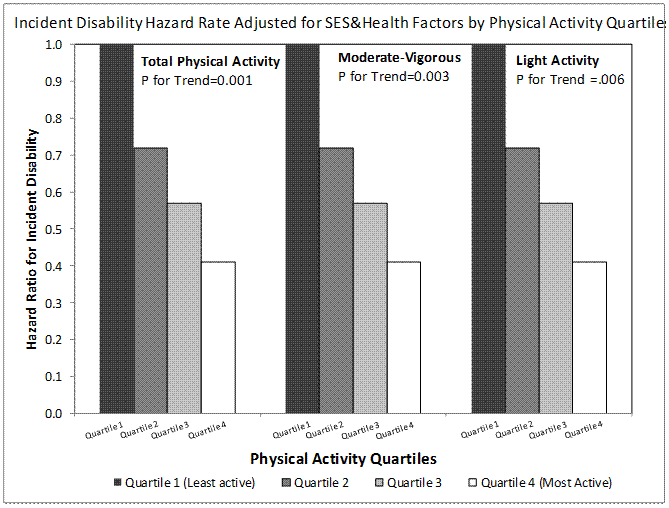Session Information
Session Type: Abstract Submissions (ACR)
Background/Purpose: Over 56 million people in the U.S. are classified as disabled. Physical activity is a low cost, broadly applicable approach to improve cardiovascular fitness, but it is not established if improved fitness translates to reduced disability, a key to containing healthcare costs. This study evaluated whether accelerometer measured physical activity is related to incident disability.
Methods: We prospectively examined the relationship of accelerometer measured physical activity with two-year development of disability measured by instrumental and basic activity of daily living limitations (IADL/ADL). We studied 1666 participants aged 49 years or older from the Osteoarthritis Initiative observational study of adults at high risk for or having knee OA and were free of baseline IADL/ADL limitations. This sample represents a large segment of community-dwelling adults at elevated risk for disability. Hazard ratios were estimated from discrete survival methods to investigate a graded relationship between baseline physical activity quartile groups and the development of disability within two years.
Results: Higher physical activity levels had a significant inverse association with the development of disability. For higher active physical activity quartiles, hazard ratios for incident disability were 1.00, 0.67, 0.51, and 0.36, respectively (P for trend, <0.001) controlling for socioeconomic (age, gender, race/ethnicity, education, income) and health factors (comorbidity, depressive symptoms, obesity, smoking, lower extremity pain, function, and knee factors: osteoarthritis severity, pain, symptoms, prior injury). Consistent trends between greater physical activity and less incident disability were demonstrated from analyses stratified by age, gender, and presence/absence of knee osteoarthritis and analyses based on time spent in moderate-intensity or light-intensity physical activities. Sensitivity analyses applying a more stringent definition of disability based on reported IADL/ADL dependency/assistance also demonstrated a statistically significant inverse graded relationships.
Conclusion: . These prospective data demonstrated an inverse relationship between higher physical activity levels and the development of disability in community-dwelling adults at elevated risk for disability. Importantly, this study demonstrated greater physical activity, regardless of intensity, was related to less incident disability. Reduced incident disability was associated with greater time spent in light intensity as well as moderate-to-vigorous intensity activities. These findings support policies that encourage adults, including persons with arthritis, to increase their physical activity of any intensity to prevent and slow disability.
Disclosure:
D. D. Dunlop,
None;
J. Song,
None;
P. A. Semanik,
None;
L. Sharma,
None;
J. M. Bathon,
None;
C. Eaton,
None;
M. C. Hochberg,
Abbvie, Inc,
5,
Bioiberica SA,
5,
Eli Lilly and Company,
5,
Genentech, Inc,
5,
Iroko Pharmaceuticals, LLC,
5,
Merck, Inc,
5,
Novartis Pharma AG,
5,
Pfizer, Inc,
5,
Savient Pharmaceuticals,
5;
R. D. Jackson,
NIH,
2;
C. K. Kwoh,
None;
W. J. Mysiw,
NIH,
2;
M. C. Nevitt,
None;
R. W. Chang,
None.
« Back to 2013 ACR/ARHP Annual Meeting
ACR Meeting Abstracts - https://acrabstracts.org/abstract/physical-activity-is-associated-with-reduced-incident-disability-evidence-from-the-osteoarthritis-initiative/

